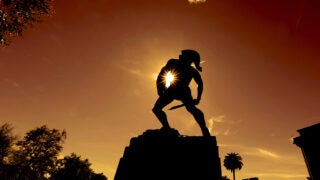When Cars Cruised Down Trousdale
With servicemen streaming to USC after World War II, an explosion in enrollment changed the university.
Before the attack on Pearl Harbor in December 1941, about 6,000 students were enrolled for day classes at USC. By the first few months of 1946, though — after World War II had ended — that number had soared to 8,300. An additional 3,500 students attended class during the evenings. Thanks to the G.I. Bill, returning servicemen swelled USC enrollment, which peaked in 1948 when the day and evening student body totaled an astonishing 24,000 Trojans.
More than 110 faculty members were hired in 1945 to teach the growing student body. Many worked double shifts as classes were held from 7 a.m. to 10 p.m., as well as on Saturdays.
USC Changes After World War II
The student influx also changed the landscape of the University Park Campus. Old army barracks were hauled in from nearby training camps to serve as temporary classroom and lab facilities. The College of Liberal Arts building — known fondly as “Old College,” it was unveiled in 1884 as the university’s first permanent structure — was deemed seismically unsafe and demolished to make room for Founders Hall (now known as Taper Hall). A dentistry building, student clinic, cafeteria, athletic field and other structures also sprang up in the post-war years.
In 1950, the university began acquiring the public streets within the bounds of Exposition and Jefferson boulevards, McClintock Avenue and Figueroa Street to create a more unified academic campus.
In the inset photo from 1952, cars still cruised down University Avenue past Doheny Memorial Library and Bovard Administration Building. Just one year later, the university won approval from 46 Los Angeles public officials to permanently shut the busy street to vehicular traffic. University Avenue was formally closed in December 1953 with great fanfare, signaling the start of a self-contained University Park Campus. The street is now USC’s main pedestrian thoroughfare that Trojans know by a different name: Trousdale Parkway.



